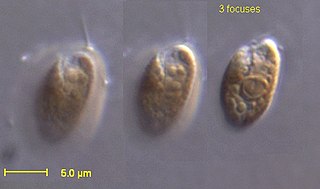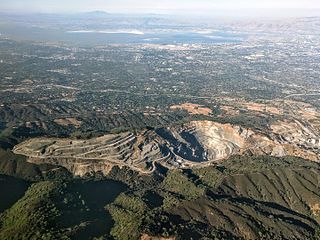
The cryptomonads are a group of algae, most of which have plastids. They are traditionally considered a division of algae among phycologists, under the name of Cryptophyta. They are common in freshwater, and also occur in marine and brackish habitats. Each cell is around 10–50 μm in size and flattened in shape, with an anterior groove or pocket. At the edge of the pocket there are typically two slightly unequal flagella. Some may exhibit mixotrophy. They are classified as clade Cryptomonada, which is divided into two classes: heterotrophic Goniomonadea and phototrophic Cryptophyceae. The two groups are united under three shared morphological characteristics: presence of a periplast, ejectisomes with secondary scroll, and mitochondrial cristae with flat tubules. Genetic studies as early as 1994 also supported the hypothesis that Goniomonas was sister to Cryptophyceae. A study in 2018 found strong evidence that the common ancestor of Cryptomonada was an autotrophic protist.

Brown algae are a large group of multicellular algae comprising the class Phaeophyceae. They include many seaweeds located in colder waters of the Northern Hemisphere. Brown algae are the major seaweeds of the temperate and polar regions. Many brown algae, such as members of the order Fucales, commonly grow along rocky seashores. Most brown algae live in marine environments, where they play an important role both as food and as a potential habitat. For instance, Macrocystis, a kelp of the order Laminariales, may reach 60 m (200 ft) in length and forms prominent underwater kelp forests that contain a high level of biodiversity. Another example is Sargassum, which creates unique floating mats of seaweed in the tropical waters of the Sargasso Sea that serve as the habitats for many species. Some members of the class, such as kelps, are used by humans as food.

Wikispecies is a wiki-based online project supported by the Wikimedia Foundation. Its aim is to create a comprehensive open content catalogue of all species; the project is directed at scientists, rather than at the general public. Jimmy Wales stated that editors are not required to fax in their degrees, but that submissions will have to pass muster with a technical audience. Wikispecies is available under the GNU Free Documentation License and CC BY-SA 3.0.

Oscillatoria is a genus of sugar making microscopic creatures.

Tetradesmus dimorphus is a freshwater unicellular green algae in the class Chlorophyceae. The name means "having two forms".

The cryptophyceae are a class of algae, most of which have plastids. About 230 species are known, and they are common in freshwater, and also occur in marine and brackish habitats. Each cell is around 10–50 μm in size and flattened in shape, with an anterior groove or pocket. At the edge of the pocket there are typically two slightly unequal flagella.
Crenotrichaceae is a family of environmental bacteria.

Chlamydomonadaceae is a family of algae within the order Chlamydomonadales. Traditionally, it has been defined as containing single-celled flagellates with a cell wall.
Oocystaceae is a family of green algae, in the order Chlorellales. The type genus is Oocystis.

The Permanente Quarry and cement plant is in an unincorporated area of Santa Clara County, California, just west of Cupertino. The limestone and aggregate mining operation and cement plant is owned by Lehigh Southwest Cement, a subsidiary of Heidelberg Cement. Limestone was mined beginning in 1902 but remained a small operation until 1939 when it was purchased by Henry J. Kaiser to supply the 5.5 million barrels of cement to build Shasta Dam. With increased production Kaiser supplied all of the cement used by the Navy in the Pacific Theater of World War 2. At 7 million barrels, it was more cement than the Shasta Dam project. Roughly 70 percent of the cement used in the communities of Santa Clara County was acquired from the cement plant.

A species is often defined as the largest group of organisms in which any two individuals of the appropriate sexes or mating types can produce fertile offspring, typically by sexual reproduction. It is the basic unit of classification and a taxonomic rank of an organism, as well as a unit of biodiversity. Other ways of defining species include their karyotype, DNA sequence, morphology, behaviour, or ecological niche. In addition, paleontologists use the concept of the chronospecies since fossil reproduction cannot be examined. The most recent rigorous estimate for the total number of species of eukaryotes is between 8 and 8.7 million. About 14% of these had been described by 2011. All species are given a two-part name, a "binomial". The first part of a binomial is the genus to which the species belongs. The second part is called the specific name or the specific epithet. For example, Boa constrictor is one of the species of the genus Boa, with constrictor being the species' epithet.
Phaeothamniophycidae is a subclass of heterokont algae. It contains two orders, Phaeothamniales and Pleurochloridellales, and consists of species separated from Chrysophyceae.

Scytonema is a genus of photosynthetic cyanobacteria that contains over 100 species. It grows in filaments that form dark mats. Many species are aquatic and are either free-floating or grow attached to a submerged substrate, while others species grow on terrestrial rocks, wood, soil, or plants. Scytonema is a nitrogen fixer, and can provide fixed nitrogen to the leaves of plants on which it is growing. Some species of Scytonema form a symbiotic relationship with fungi to produce a lichen.
Fritz Johann Hansgirg (1891–1949) was an Austrian electrochemist and metallurgist who in 1928 invented a carbothermic magnesium reduction process. In 1934, he left Austria for the Empire of Japan where he worked with industrialist Shitagau Noguchi to set up a magnesium plant, and then helped build a pilot plant to produce heavy water using a combined electrolysis catalytic exchange process he had invented. He moved to the United States in 1940, where he worked with industrialist Henry J. Kaiser to design a magnesium plant in California. In 1941, Hansgirg was arrested by the FBI on a presidential warrant and interned for "the duration of the war". After the war, the Soviet Union captured Hansgirg's plants in northern Korea, using the plants' processes and equipment for their atomic bomb project.

Stylonemataceae is a family of red algae in the class Stylonematophyceae. It is the only family in the monotypic order Stylonematales.

Chroomonadaceae is a family of cryptomonads first recognized by Clay et al in 1999 as including genera Chroomonas, Falcomonas, and Komma. Following a molecular phylogenic study in 2002, Hemiselmis was also placed within the Chroomonadaceae. Today, the family is generally recognized as sister to the Pyrenomonadaceae.
Anton Hansgirg was a Bohemian-born Austrian phycologist who described several new species of red algae, green algae, and cryptophytes, in Austria-Hungary between 1880 and 1905.
Chlorogloea is a genus of cyanobacteria belonging to the family Entophysalidaceae.
Chroodactylon is a genus of red algae belonging to the family Stylonemataceae.

Mesotaenium is a genus of algae belonging to the family Mesotaeniaceae.












